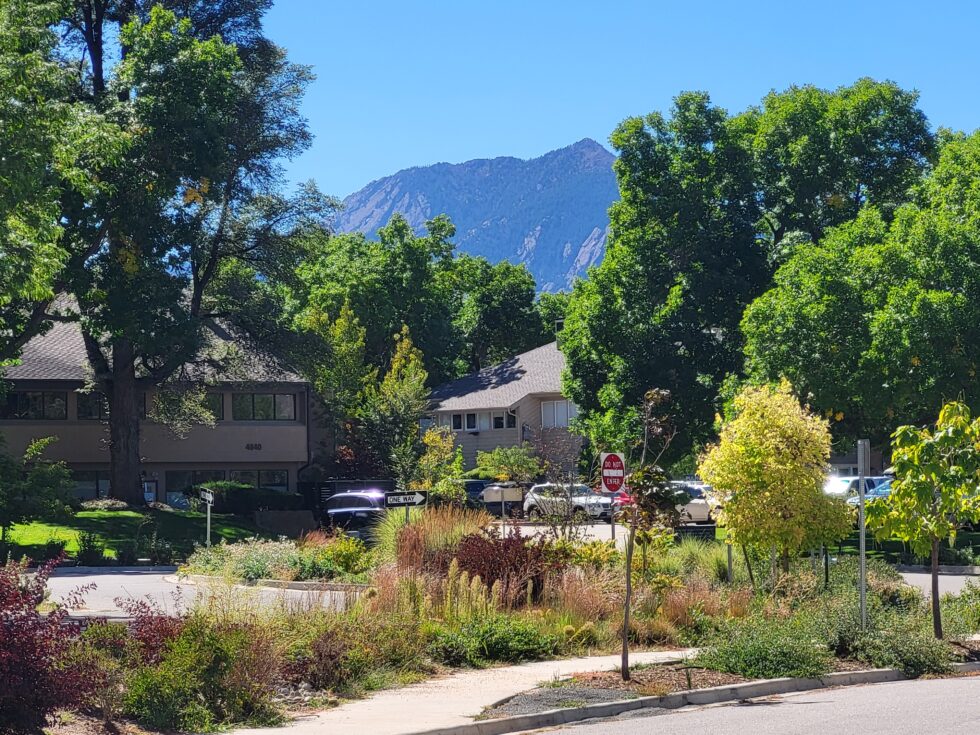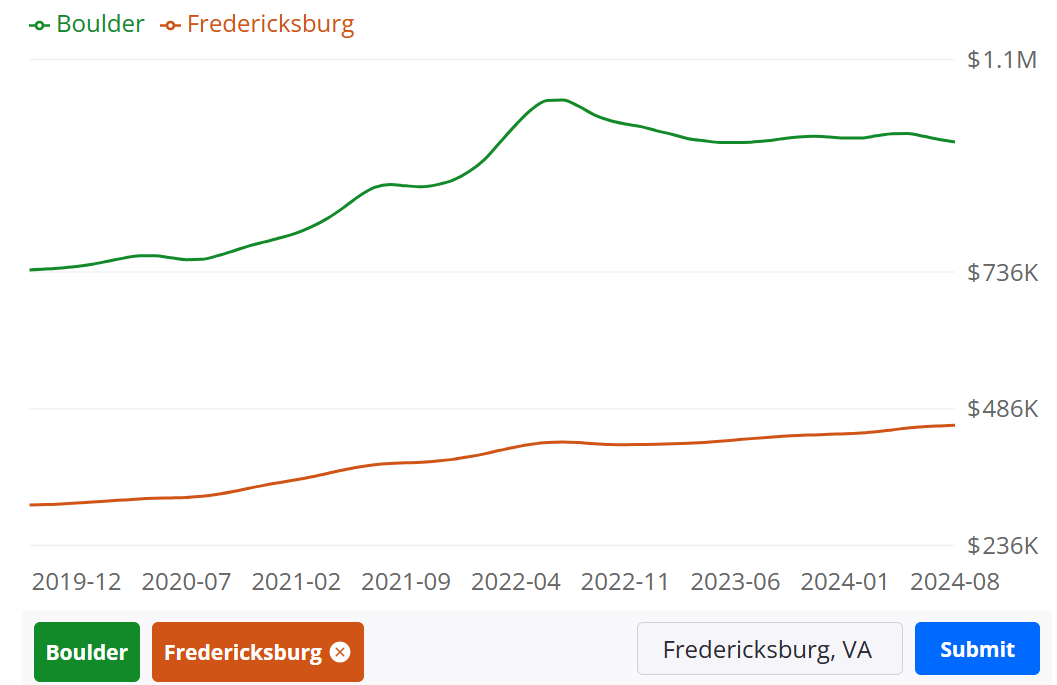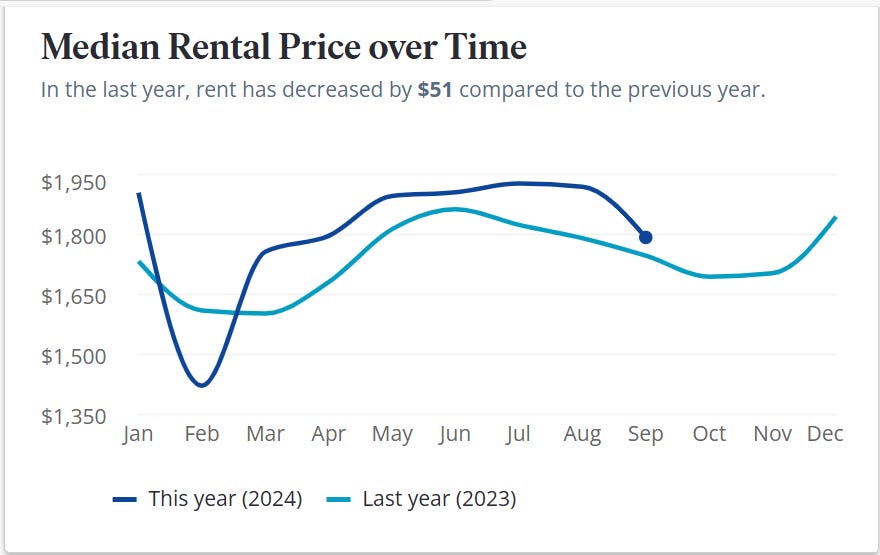
Our housing crises is serious. Boulder, Colorado’s, may be worse. Boulder offers lessons for Fredericksburg, and our region has a few things to teach Boulder, as well.
This week, Martin is in Boulder, Colorado, visiting family. He’s also filing reports about Boulder’s own housing crisis as well as the city’s robust news scene — both of which have things to teach Fredericksburg.
Fall is settling into Boulder, Colorado. The temperatures, which had been in the 90s, are dropping. And the towering Rockies lying just beyond the Flat Iron Mountains that border the home of the University of Colorado recently added a first, fresh layer of snow to their peaks.
While the weather is cooling, however, debates about the housing market are growing red-hot.
Boulder has seen home prices rise sharply in recent years. So much so that Fredericksburg’s home prices are — comparatively speaking — a bargain.

Fredericksburg and Boulder are hardly similar localities, of course. Fredericksburg is smaller (less than 30,000 residents to Boulder’s 102,000-plus, of whom about 33,000 are students at the University of Colorado). Also, Boulder has the fortune of having a major research university that drives much of its economy, which is rich in aerospace, biotech, cleantech, IT/software, natural products, and outdoor recreation.
But when it comes to addressing housing issues, the two cities share more in common than might be apparent at first blush.
Fredericksburg is land-locked at just over 10 square miles. Boulder, with almost 4-times Fredericksburg’s population, measures just some 27 square miles. The city of Boulder does sit in Boulder County, which is more than 740 square miles; however, there are significant limitations on that land. From the Boulder Reporting Project:
The city is largely surrounded by protected open space, which is off-limits for development. Height limits restrict the city from building up. And most of the city’s residential land is zoned as low density, requiring a minimum lot size of 7,000 square feet for each housing unit. This limits the number of homes that can be built on the city’s already scarce developable land.
Not surprisingly, both cities are struggling to address their respective housing crises, which are crippling each city’s ability to attract middle-income families who both fill essential jobs (teachers, first responders, small business owners, and more) and generate the type of growth a city needs to remain healthy and growing.
However, Boulder has taken some steps that Fredericksburg — as well as Spotsylvania and Stafford — could learn from. And Boulder could learn a thing or two from Planning District 16, too.
Knowing the Cost
Last week, the Denver Regional Council of Governments’ board of directors released a report detailing specifically how much housing Denver and its surrounding areas would need.
This report, the “Regional Housing Needs Assessment,” involved two steps.
The first analyzed regional data to identify gaps in housing supply and affordability across income levels and household types. The second involved extensive engagement with those involved in various sectors involved in housing to identify systemic barriers to sufficient housing development that meets the needs of people of all ages, incomes and abilities.
The results provide a target for what new housing development is necessary to lower costs and meet the needs of citizens who occupy middle and lower-income positions.
For the city of Boulder, the numbers were eye-raising, if not unexpected. From the Boulder Reporting Lab:
The City of Boulder will need 10,700 additional housing units over the next decade to meet demand while preventing rent and home prices from rising further out of reach for most people….. This would represent an approximate 23% increase in the city’s housing supply.
Ideas for how the city can proceed are bubbling.
Among them are updating “zoning rules in Medium- and low-density neighborhoods,” BRP reports, “reducing minimum open space requirements for duplexes and triplexes” and allowing people to sell their Accessory Dwelling Units.
None of these changes, of course, will come easily.
For example, this past week the Boulder County commissioners imposed a moratorium on larger homes. The idea has been in the air since August. The moratorium will last for six months and will begin in January 2025. “The goal,” reports the BRP, “is partially to allow county officials time to develop new regulations aimed at reducing housing costs and environmental impacts linked to large homes.”
Unsurprisingly, the move has both supporters and critics, both of whom are making their voices known.
The new housing report the city now has, however, that spells out the magnitude of the challenge before it — needing at least 10,700 new homes, most of them affordable — should bring some clarity to what it needs to do as it plans for the future during the moratorium period.
Planning to address the affordable housing crisis is, and has been, underway in our region. The 2020 Housing Affordability and Action Plan identified a number of the most pressing issues that our area faces as it regards housing. Among the major takeaways:
- One in two renters in the region are cost burdened. An overwhelming majority of those cost-burdened renters are low- and moderate-income households.
- There is little rental housing that is dedicated to low- and moderate-income households in the region. Only 7% of all the new homes built in the region over the past decade use public assistance to provide below-market rate rents.
- The price of homeownership continues to increase as supply dwindles. Over the past five years, the price of a home has risen nearly 20%.
- First-time homebuyers are being priced out of the market. As of June 2020, 1 in 5 home resales were below $250,000 in 2020. Of all new construction sales in 2019 and 2020, only 3% were below $250,000.
- Homebuyers are looking for homes that aren’t being built. The average new home constructed is over 3,000 square feet, but the highest demand is for smaller homes.
- Senior housing needs will be a significant portion of future housing demand. One in five residents in the region will be 65 years or older by 2040.
A great deal has changed since that study, of course. The median rent for an apartment in Stafford County at that time was $1,543. Today, that number has soared to $1,793. A 16% increase.

An updated study is underway now, according to Kim McClellan of the Fredericksburg Association of Area Realtors. She tells the Advance that this will be “a housing gap analysis to examine how local resident wages match up to our current housing stock and identify what we are missing. The study will not include recommendations on what to build, just provide the data on where we are at.”
Another positive step in our area has been the development of the Regional Housing Assembly here in Planning District 16. It hosted the first annual Regional Housing Summit in 2023, and it will host the second summit set for October 24, 2024.
Learning from Boulder
So what can Fredericksburg learn from Boulder, and vice-versa?
Some 30,000-foot ideas include the following:
- Fredericksburg and its surrounding counties are doing a sound job on the policy front, but Planning District 16 could benefit from a study that spells out the numbers and types of housing that our area is going to need into the future.
- Like Boulder, Fredericksburg needs to become more outspoken about the role inequality plays in the housing issue. The two cities are dissimilar in the inequalities they must face, however. Boulder, which is nearly 80% white, must deal with the realities of income inequality, and a local tax system that raises taxes on more-affordably priced homes as newer homes are established in their neighborhoods. Fredericksburg must face income inequality and well as the fast-changing racial demographics in our region.
- Fredericksburg and its surrounding counties have an opportunity that Boulder currently does not — data centers. Colorado pales in comparison to Virginia in the number of data centers it has. With centers coming online in Spotsylvania, Stafford, Caroline, and potentially in Fredericksburg, the region will gain access to a stream of income that may provide some financial flexibility required to begin making homes more affordable. To be sure, other needs will compete for those dollars – especially education – but citizens should be petitioning their representatives now to begin coming up with plans for how data center funding can help ease the crisis our area is facing.
Perhaps the greatest lesson that Fredericksburg can learn from Boulder is this. You cannot wish your way out of a housing crunch. Boulder has had opportunities in the recent past to take steps to ease the pain the region is currently experiencing and has failed to do so.
Fredericksburg, Spotsylvania, and Stafford need to begin taking action now to avoid housing costs like those facing people today in Boulder.




Local Obituaries
To view local obituaries or to send a note to family and loved ones, please visit our website at the link that follows.

Support Award-winning, Locally Focused Journalism

The FXBG Advance cuts through the talking points to deliver both incisive and informative news about the issues, people, and organizations that daily affect your life. And we do it in a multi-partisan format that has no equal in this region. Over the past month, our reporting was:
$8 a month supports great journalism
- First to report on a Spotsylvania School teacher arrested for bringing drugs onto campus.
- First to report on new facility fees leveled by MWHC on patient bills.
- First to detail controversial traffic numbers submitted by Stafford staff on the Buc-ee’s project
- Provided extensive coverage of the cellphone bans that are sweeping local school districts.
- And so much more, like Clay Jones, Drew Gallagher, Hank Silverberg, and more.
For just $8 a month, you can help support top-flight journalism that puts people over policies.
Your contributions 100% support our journalists.
Help us as we continue to grow!
Support FXBG Advance for $8 a month







